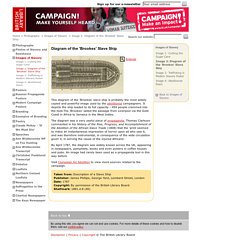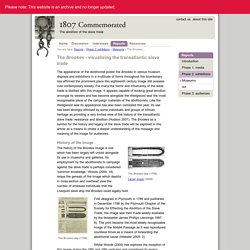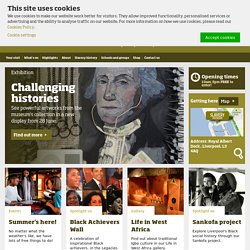

Les traites négrières. 4H1T3- Les traites négrières et l'esclavage – Activités. La traite négrière transatlantique [infographie] [carte] Temps de lecture: 2 min D'habitude, quand nous évoquons «l'esclavage américain» ou «la traite américaine des esclaves», nous faisons référence aux colonies américaines ou, plus tard, aux Etats-Unis.
![La traite négrière transatlantique [infographie] [carte]](http://cdn.pearltrees.com/s/pic/th/transatlantique-infographie-110648132)
Mais quand on s'intéresse à la traite négrière dans son ensemble, l'Amérique du nord ne joue qu'un rôle secondaire. Depuis le début de la traite, au XVIe siècle, jusqu'à sa fin, au XIXe siècle, les marchands d'esclaves ont transporté la plupart des Africains asservis à deux endroits: dans les Caraïbes et au Brésil. Parmi les plus de 10 millions d'esclaves africains qui sont finalement arrivés de l'autre côté, 388.747 –moins de 4% du total– sont arrivés en Amérique du nord. Contre 1,3 million en l'Amérique centrale, appartenant alors à l'Espagne, 4 millions amenés dans les colonies britanniques, françaises, néerlandaises et danoises dans les Caraïbes et 4,8 millions transportés au Brésil. Quelques tendances ressortent. A year of ships. What Happened on the Brookes Slave Ship? In the mid-1600s, trader John Hawkins sailed from England to the west coast of Africa, where he purchased African slaves.

He sailed west to the Caribbean, where he traded the slaves for sugar and tobacco before returning home. Hawkins' journey initiated Great Britain's 150-year long "triangular trade," which would lead to the enslavement of approximately 3.1 million Africans. Of the many slave-trading ships, none achieved the notoriety of the Brookes. A poster depicting its human cargo and the deplorable conditions onboard was instrumental in ultimately abolishing Great Britain's slave trade. A Swift Slaver. Many Passages: The Voyage of the Slave Ship Brookes · HERB: Resources for Teachers. Step 1: Divide students into three smaller groups.

Assign each group a perspective on the transatlantic slave trade to represent in their narratives: Captain, Sailor, or Captive. Step 2: Hand out the documents. In their groups, students should review the documents and discuss what information or insights each document tells about their assigned historical perspectives. Step 3: Using evidence from the documents, each group should reconstruct the story of the Brooks voyage with a beginning, middle, and end. Each narrative should be told from the group's assigned historical perspective (Captain, Sailor, or Captive) and should address the following questions: When and where did the voyage start for you? Step 4: Each group should complete the "Writing History" worksheet, showing which parts of their stories are based in historical facts and which parts are historical inferences. A War at the Heart of Man: The Structure and Construction of Ship. Diagram of the 'Brookes' Slave Ship. This diagram of the 'Brookes' slave ship is probably the most widely copied and powerful image used by the abolitionist campaigners.

It depicts the ship loaded to its full capacity - 454 people crammed into the hold.The 'Brookes' sailed the passage from Liverpool via the Gold Coast in Africa to Jamaica in the West Indies. The diagram was a very useful piece of propaganda. Thomas Clarkson commented in his History of the Rise, Progress, and Accomplishment of the Abolition of the African Slave Trade (1808) that the 'print seemed to make an instantaneous impression of horror upon all who saw it, and was therefore instrumental, in consequence of the wide circulation given it, in serving the cause of the injured Africans'. By April 1787, the diagram was widely known across the UK, appearing in newspapers, pamphlets, books and even posters in coffee houses and pubs.
An image had rarely been used as a propaganda tool in this way before. PortCities Bristol. Bristol and Transatlantic Slavery. A History of the World - Object : The Brooks slave ship drawing. Chart of the Voyages of the Slave Ship Brookes · HERB: Resources for Teachers. Britain and the trade. The Brookes - visualising the transatlantic slave trade. You are here: Reports » Phase 2: exhibitions » Museums » The Brookes...

The appearance of the abolitionist poster the Brookes in various museum displays and exhibitions in a multitude of forms throughout the bicentenary has affirmed the prominent place this eighteenth century image still possess over contemporary society. For many the horror and inhumanity of the slave trade is distilled with this image. Trans-Atlantic Slave Trade - Database. Slave Voyages. USI Home Page. MapSlaveRoute. The Middle Passage. International Slavery Museum, Liverpool museums. Read on Events Summer's here!

No matter what the weather's like, we have lots of free things to do! Read on Spotlight on Black Achievers Wall A celebration of inspirational Black achievers, in the Legacies gallery. Read on Gallery Life in West Africa Find out about traditional Igbo culture in our Life in West Africa gallery. Read on Sankofa project Explore Liverpool's Black social history through our Sankofa project. Transatlantic Slave Trade. The transatlantic slave trade is unique within the universal history of slavery for three main reasons: its duration - approximately four centuriesthose vicitimized: black African men, womenand children the intellectual legitimization attempted on its behalf - the development of an anti-black ideology and its legal organization, the notorious Code noir.

As a commercial and economic enterprise, the slave trade provides a dramatic example of the consequences resulting from particular intersections of history and geography. It involved several regions and continents: Africa, America, the Caribbean, Europe and the Indian Ocean. Tuto intégrer GigaPixel dans StoryMapJS avec GITHUB. Teacher's map. Concours « La Flamme de l'égalité »